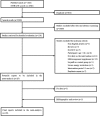Effects of dairy intake on body weight and fat: a meta-analysis of randomized controlled trials
- PMID: 22932282
- PMCID: PMC3441106
- DOI: 10.3945/ajcn.112.037119
Effects of dairy intake on body weight and fat: a meta-analysis of randomized controlled trials
Abstract
Background: Some intervention studies have suggested that dairy products may influence body weight, but the results remain controversial.
Objective: We identified and quantified the effects of dairy consumption on body weight and fat mass from randomized controlled trials (RCTs).
Design: We conducted a comprehensive search of PubMed and EMBASE databases (to April 2012) of English reports of RCTs regarding dairy consumption on body weight, body fat, or body weight and body fat in adults. The results across studies were pooled by using a random-effects meta-analysis.
Results: Twenty-nine RCTs were included with a total of 2101 participants. Overall, consumption of dairy products did not result in a significant reduction in weight (-0.14 kg; 95% CI: -0.66, 0.38 kg; I² = 86.3%). In subgroup analysis, consumption of dairy products reduced body weight in the context of energy restriction or short-term intervention (<1 y) trials but had the opposite effect in ad libitum dietary interventions or long-term trials (≥1 y). Twenty-two RCTs that reported results on body fat showed a modest reduction in the dairy group (-0.45 kg; 95% CI: -0.79, -0.11 kg; I² = 70.9%), and further stratified analysis indicated significant beneficial effects of dairy intervention on body fat in energy-restricted or short-term trials but not in long-term or ad libitum studies.
Conclusions: This meta-analysis does not support the beneficial effect of increasing dairy consumption on body weight and fat loss in long-term studies or studies without energy restriction. However, dairy products may have modest benefits in facilitating weight loss in short-term or energy-restricted RCTs.
Figures







Comment in
-
Dairy food and body fat: when the epidemiologist meets the physiologist.Am J Clin Nutr. 2013 Feb;97(2):447-8. doi: 10.3945/ajcn.112.053512. Am J Clin Nutr. 2013. PMID: 23335790 No abstract available.
-
Reply to A Tremblay.Am J Clin Nutr. 2013 Feb;97(2):448. doi: 10.3945/ajcn.112.053678. Am J Clin Nutr. 2013. PMID: 23447829 No abstract available.
Similar articles
-
Dairy Intake Enhances Body Weight and Composition Changes during Energy Restriction in 18-50-Year-Old Adults-A Meta-Analysis of Randomized Controlled Trials.Nutrients. 2016 Jul 1;8(7):394. doi: 10.3390/nu8070394. Nutrients. 2016. PMID: 27376321 Free PMC article.
-
Effect of dairy consumption on weight and body composition in adults: a systematic review and meta-analysis of randomized controlled clinical trials.Int J Obes (Lond). 2012 Dec;36(12):1485-93. doi: 10.1038/ijo.2011.269. Epub 2012 Jan 17. Int J Obes (Lond). 2012. PMID: 22249225 Review.
-
Effects of Dairy Products Consumption on Body Weight and Body Composition Among Adults: An Updated Meta-Analysis of 37 Randomized Control Trials.Mol Nutr Food Res. 2018 Jan;62(1). doi: 10.1002/mnfr.201700410. Mol Nutr Food Res. 2018. PMID: 29058378
-
High intake of dairy during energy restriction does not affect energy balance or the intestinal microflora compared with low dairy intake in overweight individuals in a randomized controlled trial.Appl Physiol Nutr Metab. 2018 Jan;43(1):1-10. doi: 10.1139/apnm-2017-0234. Epub 2017 Aug 22. Appl Physiol Nutr Metab. 2018. PMID: 28829923 Clinical Trial.
-
Consumption of Dairy Products in Relation to Changes in Anthropometric Variables in Adult Populations: A Systematic Review and Meta-Analysis of Cohort Studies.PLoS One. 2016 Jun 16;11(6):e0157461. doi: 10.1371/journal.pone.0157461. eCollection 2016. PLoS One. 2016. PMID: 27310919 Free PMC article. Review.
Cited by
-
Energy - a scoping review for the Nordic Nutrition Recommendations 2023 project.Food Nutr Res. 2023 Nov 14;67. doi: 10.29219/fnr.v67.10233. eCollection 2023. Food Nutr Res. 2023. PMID: 38084151 Free PMC article.
-
Impact of Breakfast Skipping and Breakfast Choice on the Nutrient Intake and Body Mass Index of Australian Children.Nutrients. 2016 Aug 10;8(8):487. doi: 10.3390/nu8080487. Nutrients. 2016. PMID: 27517957 Free PMC article.
-
The relationship between intake of fruits, vegetables and dairy products with overweight and obesity in a large sample in Iran: Findings of STEPS 2016.Front Nutr. 2023 Jan 17;9:1082976. doi: 10.3389/fnut.2022.1082976. eCollection 2022. Front Nutr. 2023. PMID: 36733471 Free PMC article.
-
Milk-Fat-Globule-Membrane-Enriched Dairy Milk Compared with a Soy-Lecithin-Enriched Beverage Did Not Adversely Affect Endotoxemia or Biomarkers of Gut Barrier Function and Cardiometabolic Risk in Adults with Metabolic Syndrome: A Randomized Controlled Crossover Trial.Nutrients. 2023 Jul 23;15(14):3259. doi: 10.3390/nu15143259. Nutrients. 2023. PMID: 37513677 Free PMC article. Clinical Trial.
-
Dairy Consumption and Cardiometabolic Risk Factors in Patients with Type 2 Diabetes and Overweight or Obesity during Intensive Multidisciplinary Weight Management: A Prospective Observational Study.Nutrients. 2020 Jun 2;12(6):1643. doi: 10.3390/nu12061643. Nutrients. 2020. PMID: 32498266 Free PMC article.
References
-
- Flegal KM, Carroll MD, Kit BK, Ogden CL. Prevalence of obesity and trends in the distribution of body mass index among US adults, 1999-2010. JAMA 2012;307:491–7 - PubMed
-
- Hossain P, Kawar B, El Nahas M. Obesity and diabetes in the developing world–a growing challenge. N Engl J Med 2007;356:213–5 - PubMed
-
- Barr SI. Increased dairy product or calcium intake: is body weight or composition affected in humans? J Nutr 2003;133:245S–8S - PubMed
-
- Barr SI, McCarron DA, Heaney RP, Dawson-Hughes B, Berga SL, Stern JS, Oparil S. Effects of increased consumption of fluid milk on energy and nutrient intake, body weight, and cardiovascular risk factors in healthy older adults. J Am Diet Assoc 2000;100:810–7 - PubMed
-
- Manios Y, Moschonis G, Koutsikas K, Papoutsou S, Petraki I, Bellou E, Naoumi A, Kostea S, Tanagra S. Changes in body composition following a dietary and lifestyle intervention trial: the postmenopausal health study. Maturitas 2009;62:58–65 - PubMed
Publication types
MeSH terms
Grants and funding
LinkOut - more resources
Full Text Sources
Medical
Miscellaneous

